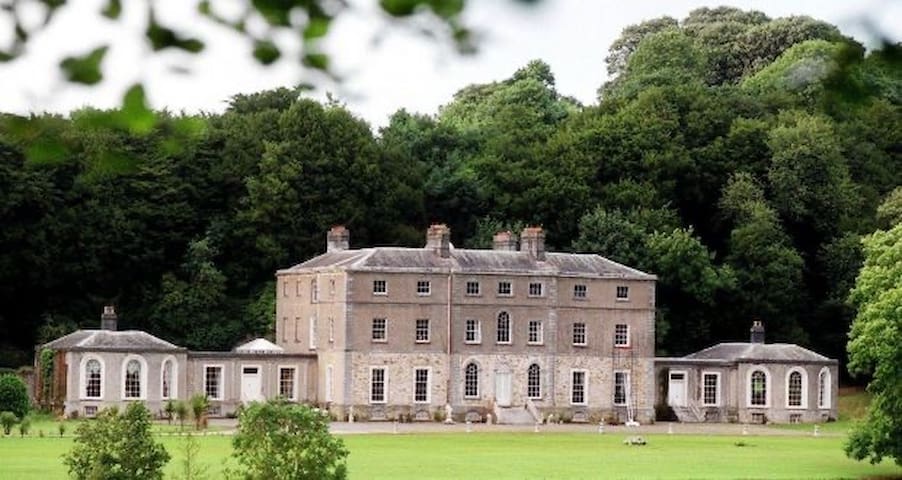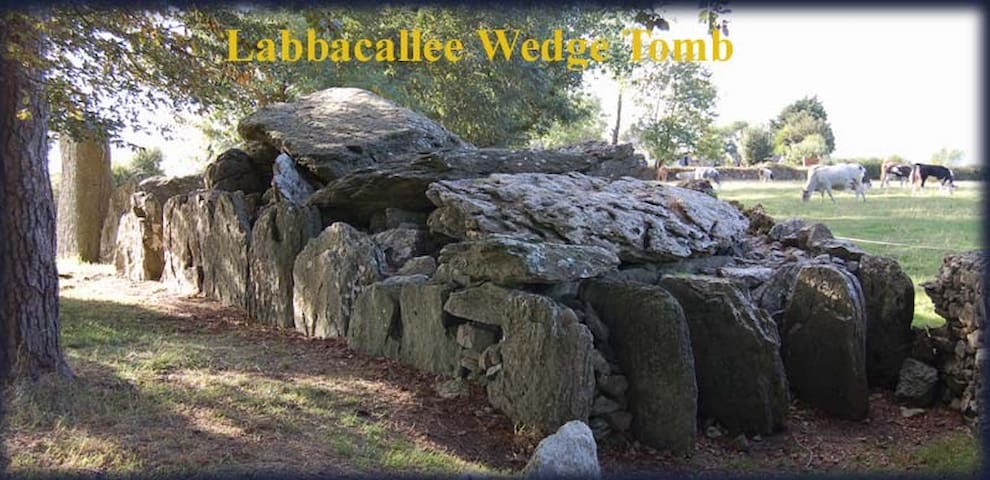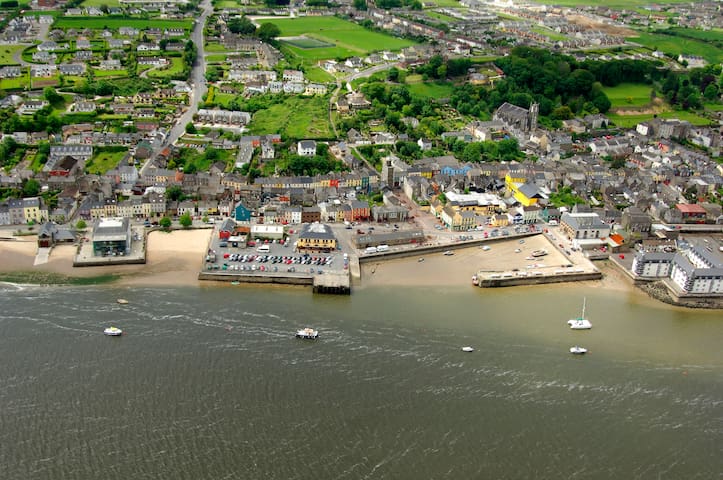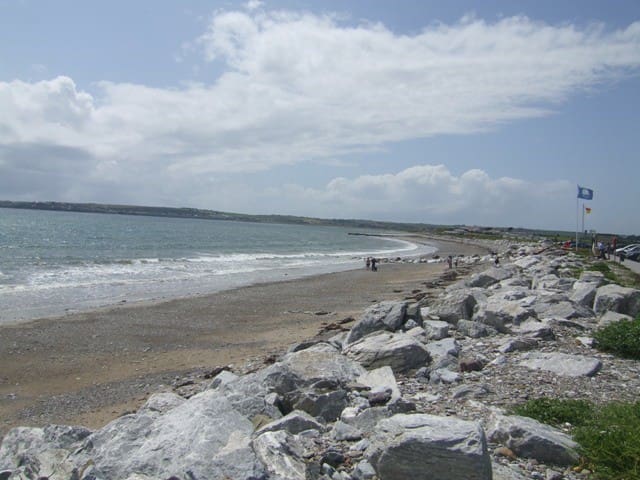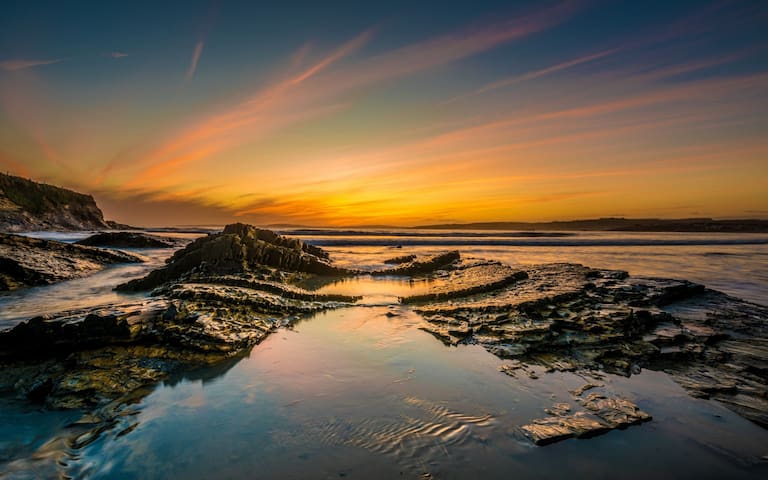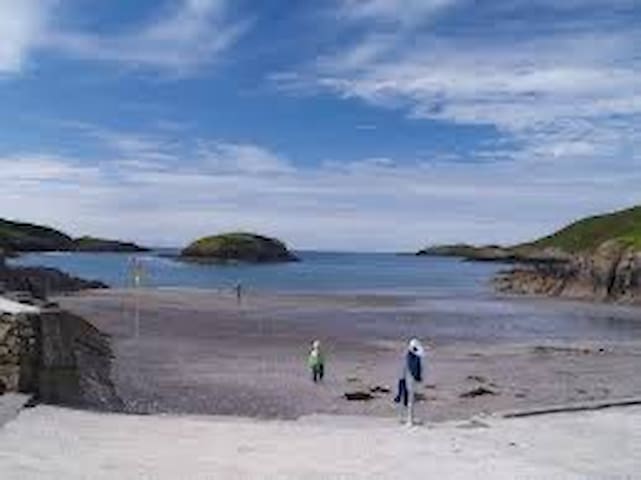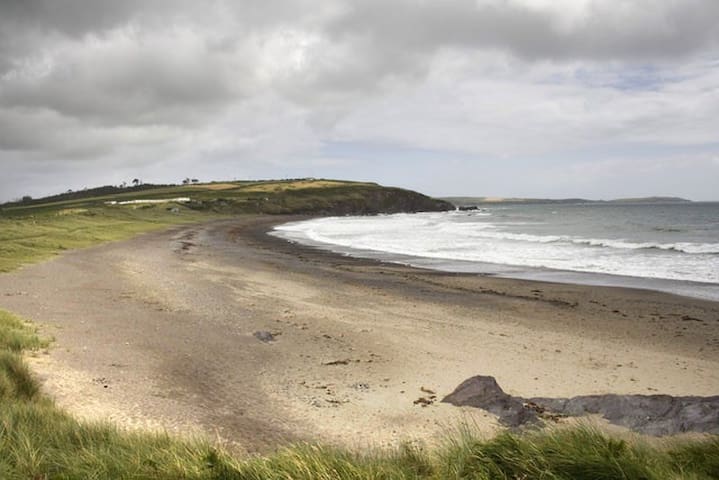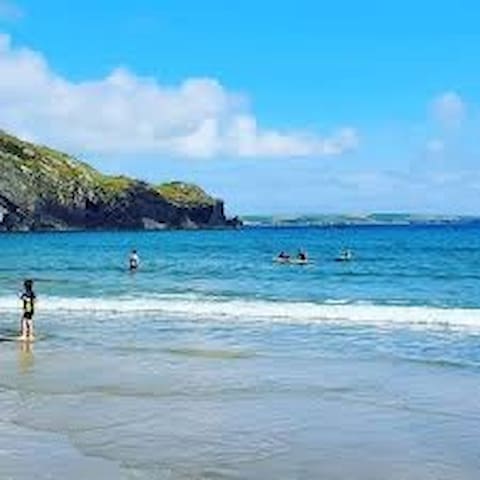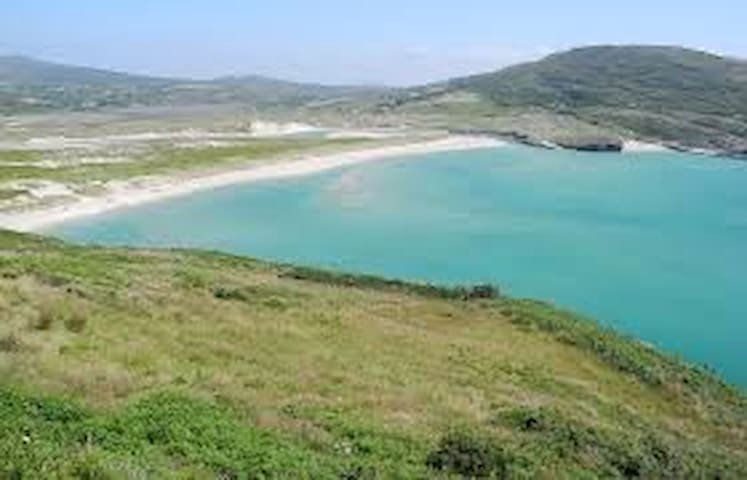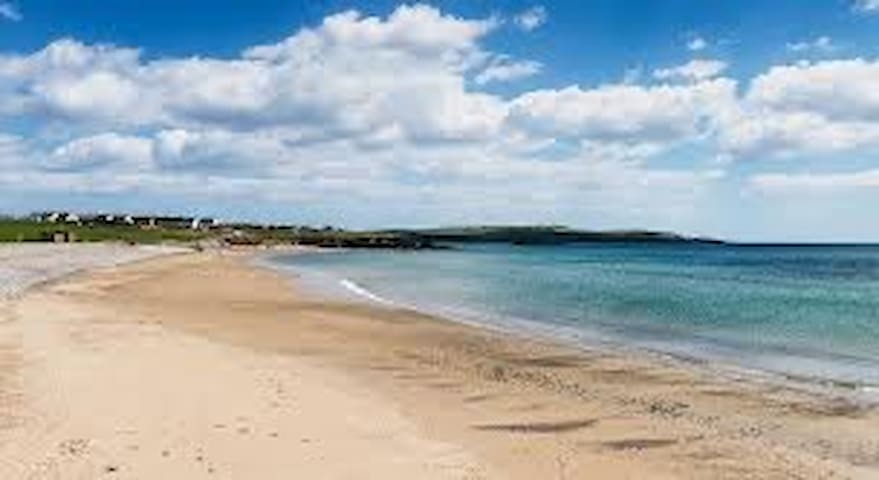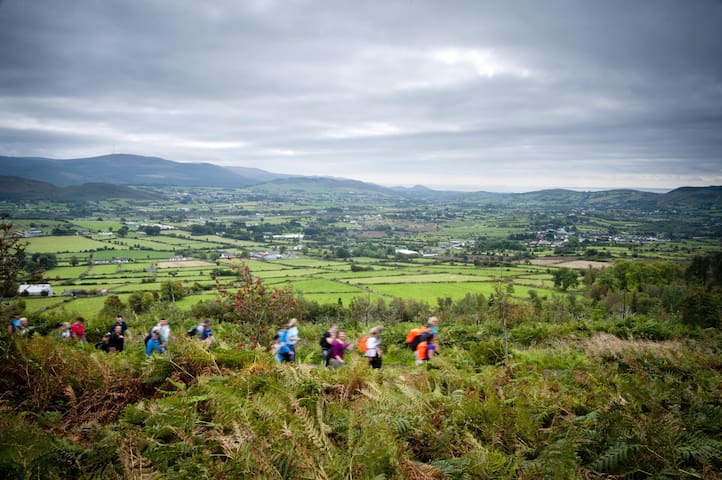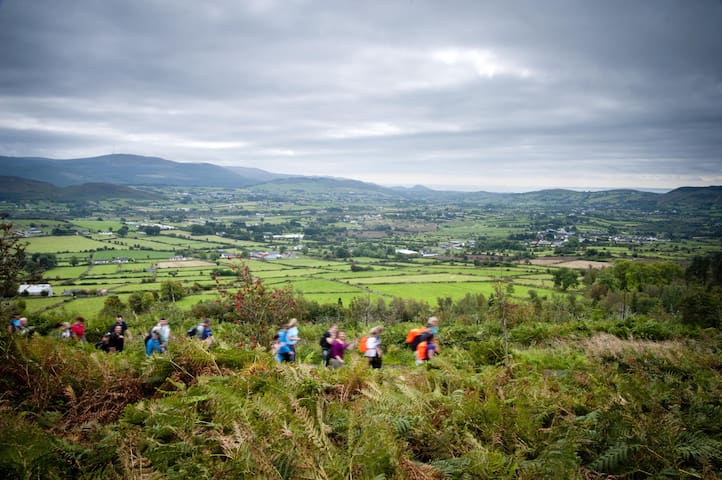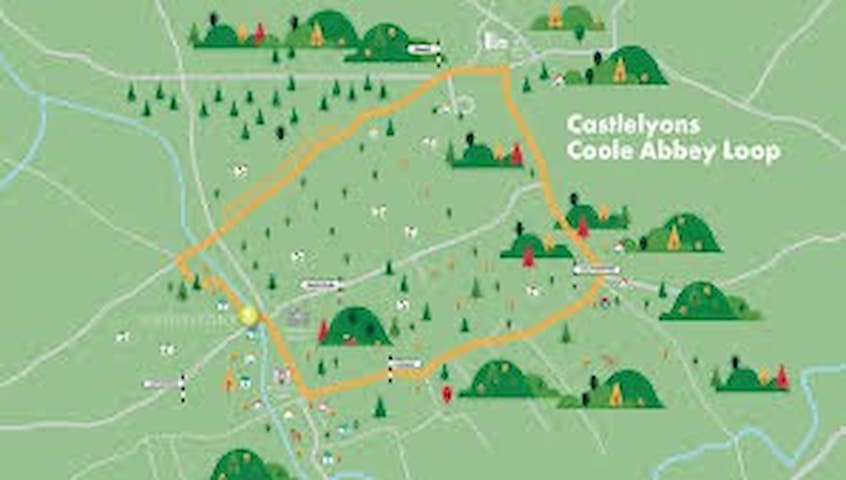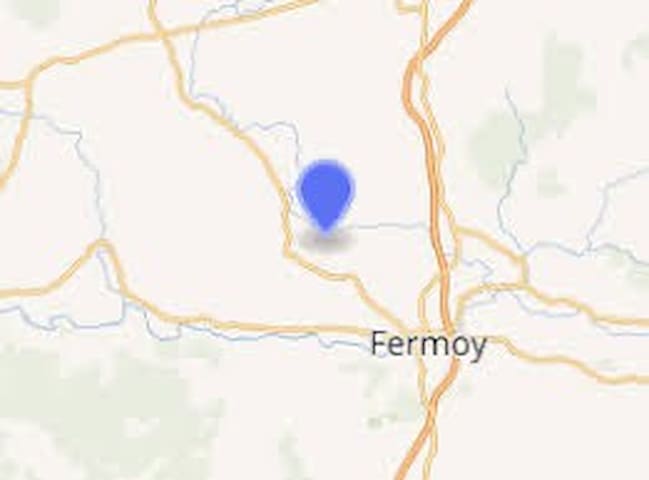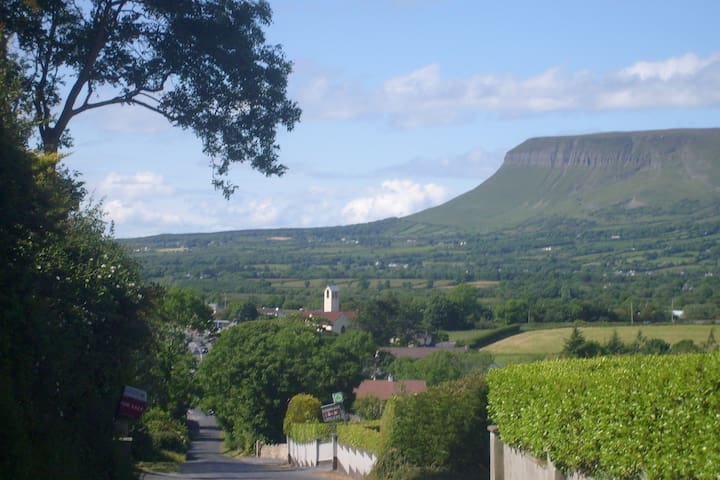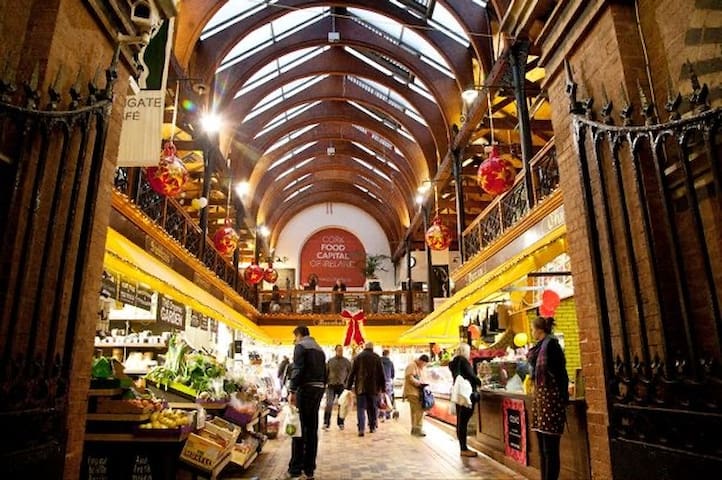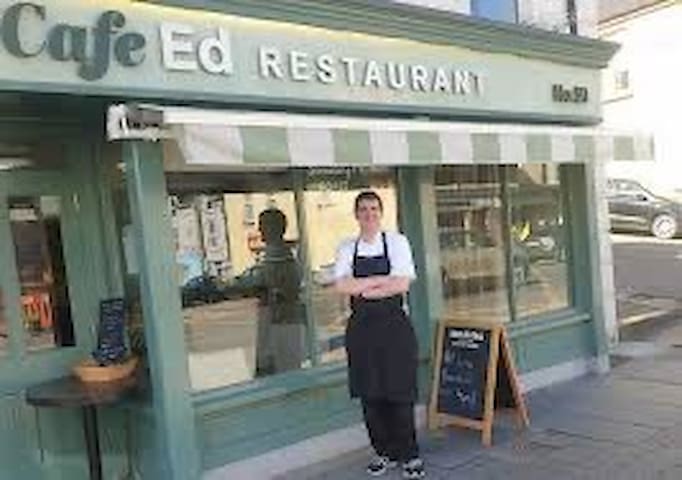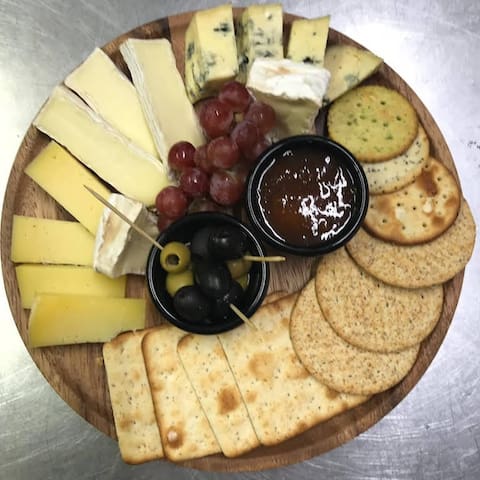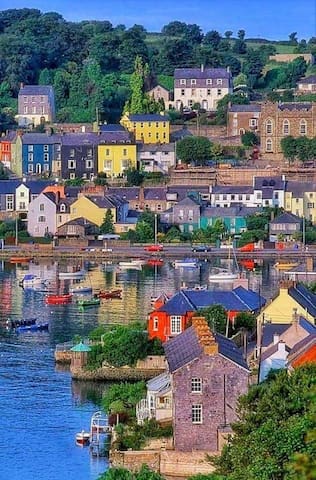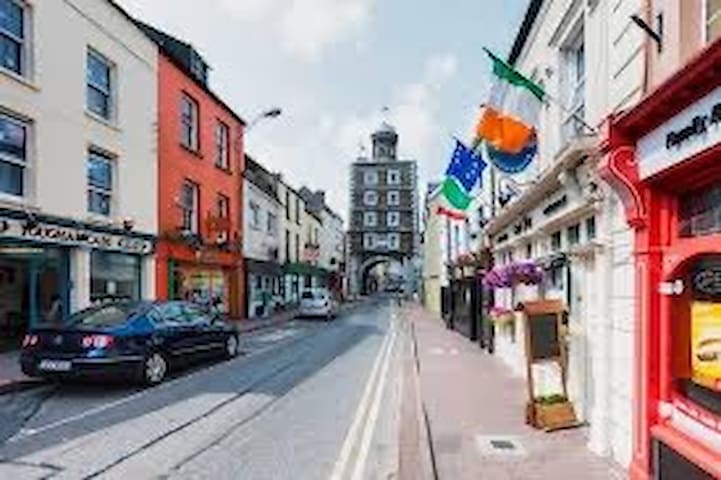Historical sights
Historical towns, landmarks, places of interest and museums
Castlehyde House
Home to Michael Flatly (Lord of the Dance)
Labbacallee
The wedge tomb at Labbacallee is the largest of all the Irish wedge tombs, known as the Hag's Bed the tomb is associated with the Celtic Hag -Goddess 'Caillech Bhearra' The gallery is covered by three massive capstones, the largest weights around ten tonnes and the tomb has three large buttress stones at the rear set parrallel to the gallery these can be seen above. The tomb is also triple walled with large stones also shown above and in the image below.
Labbacallee Wedge Tomb
Labbacallee
The wedge tomb at Labbacallee is the largest of all the Irish wedge tombs, known as the Hag's Bed the tomb is associated with the Celtic Hag -Goddess 'Caillech Bhearra' The gallery is covered by three massive capstones, the largest weights around ten tonnes and the tomb has three large buttress stones at the rear set parrallel to the gallery these can be seen above. The tomb is also triple walled with large stones also shown above and in the image below.
Freestanding Board of First Fruits-style former Church of Ireland church, dated 1809, remodelled c. 1830, now disused. Comprising four-bay nave with three-stage tower to west, having slightly projecting gabled entrance bay flanked by porches with gables to front and side elevations. Pitched slate roofs, tower having square-plan bottom stage, octagonal-plan drum with corbel table, crenellations and spire. Roughcast rendered walls to nave, having cut limestone buttresses flanking eastern three bays. Cut sandstone walls to porches, with carved limestone date plaques to north and south gables having heraldic motifs, and having ashlar limestone quoins, plinth courses and carved limestone copings terminating in decorative scrolls and gables surmounted by ornate stepped carved finials. Ashlar limestone to entrance bay with similar detailing to gable. Cut sandstone walls to tower, with string course between stages. West elevation has cut limestone plinth. Pointed arch openings to nave, some blocked up, others with timber Y-tracery windows, all with rendered sills. Square-headed triple-light windows to front elevations of porches, having cut limestone block-and-start surrounds with carved limestone label-mouldings with decorative stops and remains of timber cinquefoil heads, with cast-iron bars. Lancet windows to nolrth and side elevations of porches, having cut limestone block-and-start surrounds with carved limestone hood-mouldings and remains of decorative timber tracery comprising double-light over single cinquefoil light. Quatrefoil openings to middle stage of tower, with fixed timber windows. Ogee-headed cut limestone openings to drum, with timber louvers. Ashlar limestone entrance bay comprises recesseddoorway having pointed arch opening with carved limestone hood-moulding having ornate stops. Carved limestone hood-moulding to extenal face of entrance, with decorative carved hood-moulding with decorative stops. Inscribed blind lancets flanking doorway. Carved blind quatrefoil to pediment, set in round frame. Graveyard to site with some elaborate monuments and having roughly dressed sandstone piers to road entrance, with double-leaf wrought-iron vehicular and pedestrian gates, and pointed arch pedestrian entrance towards Castle Hyde, all set to rubble sandstone boundary walls.
Castlehyde Church Ruins
Freestanding Board of First Fruits-style former Church of Ireland church, dated 1809, remodelled c. 1830, now disused. Comprising four-bay nave with three-stage tower to west, having slightly projecting gabled entrance bay flanked by porches with gables to front and side elevations. Pitched slate roofs, tower having square-plan bottom stage, octagonal-plan drum with corbel table, crenellations and spire. Roughcast rendered walls to nave, having cut limestone buttresses flanking eastern three bays. Cut sandstone walls to porches, with carved limestone date plaques to north and south gables having heraldic motifs, and having ashlar limestone quoins, plinth courses and carved limestone copings terminating in decorative scrolls and gables surmounted by ornate stepped carved finials. Ashlar limestone to entrance bay with similar detailing to gable. Cut sandstone walls to tower, with string course between stages. West elevation has cut limestone plinth. Pointed arch openings to nave, some blocked up, others with timber Y-tracery windows, all with rendered sills. Square-headed triple-light windows to front elevations of porches, having cut limestone block-and-start surrounds with carved limestone label-mouldings with decorative stops and remains of timber cinquefoil heads, with cast-iron bars. Lancet windows to nolrth and side elevations of porches, having cut limestone block-and-start surrounds with carved limestone hood-mouldings and remains of decorative timber tracery comprising double-light over single cinquefoil light. Quatrefoil openings to middle stage of tower, with fixed timber windows. Ogee-headed cut limestone openings to drum, with timber louvers. Ashlar limestone entrance bay comprises recesseddoorway having pointed arch opening with carved limestone hood-moulding having ornate stops. Carved limestone hood-moulding to extenal face of entrance, with decorative carved hood-moulding with decorative stops. Inscribed blind lancets flanking doorway. Carved blind quatrefoil to pediment, set in round frame. Graveyard to site with some elaborate monuments and having roughly dressed sandstone piers to road entrance, with double-leaf wrought-iron vehicular and pedestrian gates, and pointed arch pedestrian entrance towards Castle Hyde, all set to rubble sandstone boundary walls.
The wooded hill of Corrin is a prominent landmark for thousands of motorists that pass it each day on the M8 Cork to Dublin motorway. The hill rises from the surrounding plain to a height of 222 metres (728 feet) at the summit, from where there are spectacular views of the surrounding countryside.
Corrin Wood is a very historical site. The mound at the summit forms ‘Carn Thiernagh’ which dates back over 3000 years to the Bronze Age. The Druid Mogh Ruith is said to be buried here. Encircling the summit are the remains of a ring fort which dates to the early Iron Age. A large stone cross was erected on the peak in 1933. It makes an impressive appearance from the M8 when it is illuminated at night during Christmas and Easter celebrations. One can contemplate the Fourteen Stations of the Cross that can be found along the forest road to the summit. These represent the final events in the Passion of Christ.
Corrin Wood
The wooded hill of Corrin is a prominent landmark for thousands of motorists that pass it each day on the M8 Cork to Dublin motorway. The hill rises from the surrounding plain to a height of 222 metres (728 feet) at the summit, from where there are spectacular views of the surrounding countryside.
Corrin Wood is a very historical site. The mound at the summit forms ‘Carn Thiernagh’ which dates back over 3000 years to the Bronze Age. The Druid Mogh Ruith is said to be buried here. Encircling the summit are the remains of a ring fort which dates to the early Iron Age. A large stone cross was erected on the peak in 1933. It makes an impressive appearance from the M8 when it is illuminated at night during Christmas and Easter celebrations. One can contemplate the Fourteen Stations of the Cross that can be found along the forest road to the summit. These represent the final events in the Passion of Christ.
Castlelyons Castle in the barony of Barrymore is the skeletal remains of an early 17th century castle. Castlelyons itself was originally named after the sept of Lehan who were situated there prior to the Anglo-Norman conquest. In the early 13th century the confiscated land was granted by King John to Philip de Barry who erected the first castle in 1206. The de Barry’s later became the Earls of Barrymore and in 1621 on the marriage of David Barry to Alice Boyle a new castle of limestone was built on the site of the earlier 13th century fortification. It was the Irish residence of the Barrymores until 1771 when it was burnt down in an accidental fire. The fire was attributed to two workmen who were carrying out repairs on the roof when the wooden beams caught alight. The castle was engulfed in flame and according to the reports at the time smouldered for almost three months. The castle was never repaired and the beautiful walled gardens that once stood in the shadow of the castle were destroyed on the orders of the earl.
Sadly the remains of the castle were ransacked for limestone in the years following the fire, however its precarious but striking ruins still stand to this day.
Castlelyons Castle
Castlelyons Castle in the barony of Barrymore is the skeletal remains of an early 17th century castle. Castlelyons itself was originally named after the sept of Lehan who were situated there prior to the Anglo-Norman conquest. In the early 13th century the confiscated land was granted by King John to Philip de Barry who erected the first castle in 1206. The de Barry’s later became the Earls of Barrymore and in 1621 on the marriage of David Barry to Alice Boyle a new castle of limestone was built on the site of the earlier 13th century fortification. It was the Irish residence of the Barrymores until 1771 when it was burnt down in an accidental fire. The fire was attributed to two workmen who were carrying out repairs on the roof when the wooden beams caught alight. The castle was engulfed in flame and according to the reports at the time smouldered for almost three months. The castle was never repaired and the beautiful walled gardens that once stood in the shadow of the castle were destroyed on the orders of the earl.
Sadly the remains of the castle were ransacked for limestone in the years following the fire, however its precarious but striking ruins still stand to this day.
Ballyhooly Castle is situated amongst woodland on the north side of the River Blackwater near the town of Mallow in County Cork.
The original castle is a five storey tower house with a relatively modern 20th century two storey fishing lodge adjoining the side of the medieval tower. The castle has been well maintained, and the house has been recently refurbished, making it a comfortable family home.
Ballyhooly Castle
14 Main StBallyhooly Castle is situated amongst woodland on the north side of the River Blackwater near the town of Mallow in County Cork.
The original castle is a five storey tower house with a relatively modern 20th century two storey fishing lodge adjoining the side of the medieval tower. The castle has been well maintained, and the house has been recently refurbished, making it a comfortable family home.
There are few villages in Ireland that pack such a wealth of history in to such a small area. A rough translation from its old Irish name (Gleann Iubhair) means the glen of the yew trees. Its offers a microcosm of Ireland’s history with ancient prehistoric sites, medieval buildings, old mills combined with some modern state of the art stores. Whether your pleasure be peaceful walks and leisurely fishing or more strenuous pursuits such as horse riding of golf, Glanworth’s rural setting guarantees a visit at your pace.
Starting Glanworth’s history is Labbacallee Megalithic Tomb which was constructed almost 5,000 years ago during the early bronze age and is said to be the finest grave of its type in Ireland.
Fast forward to the 13th century to the time of the Condon’s who built a Norman fort that still dominated the village skyline and is known as Glanworth Castle. The castle was taken over during this period by another Norman family ‘The Roches’ who ended up ruling most of the North Cork area and who subsequently invited the Dominican Order to establish an Abbey which they did in 1475.
Glanworth Bridge is a mid-15th century structure and is said to be the narrowest and oldest public bridge in everyday use in Europe. The 13 arch bridge (the first arch being buried with the construction of the Mill race) in its picturesque setting under Glanworth Castle, is one of the most photographed in the country. Care is to be taken when driving on to the bridge as it is only wide enough for 1 vehicle at a time.
In the 18th Century Glanworth was touched by the Industrial revolution with the opening of its first Mill. This is now a 4 star B&B with a restaurant.
Glanworth Holy Shrine. The shrine marks the site of a house where a blacksmith lived before he emigrated to America in the late 19 century. His son became the Archbishop of Boston, Cardinal Richard Cushing who officiated at the marriage and burial of the US assassinated President John. F. Kennedy.
Glanworth is approximately 6 miles/10KM’s from Fermoy. Simply follow the
Glanworth Bridge
There are few villages in Ireland that pack such a wealth of history in to such a small area. A rough translation from its old Irish name (Gleann Iubhair) means the glen of the yew trees. Its offers a microcosm of Ireland’s history with ancient prehistoric sites, medieval buildings, old mills combined with some modern state of the art stores. Whether your pleasure be peaceful walks and leisurely fishing or more strenuous pursuits such as horse riding of golf, Glanworth’s rural setting guarantees a visit at your pace.
Starting Glanworth’s history is Labbacallee Megalithic Tomb which was constructed almost 5,000 years ago during the early bronze age and is said to be the finest grave of its type in Ireland.
Fast forward to the 13th century to the time of the Condon’s who built a Norman fort that still dominated the village skyline and is known as Glanworth Castle. The castle was taken over during this period by another Norman family ‘The Roches’ who ended up ruling most of the North Cork area and who subsequently invited the Dominican Order to establish an Abbey which they did in 1475.
Glanworth Bridge is a mid-15th century structure and is said to be the narrowest and oldest public bridge in everyday use in Europe. The 13 arch bridge (the first arch being buried with the construction of the Mill race) in its picturesque setting under Glanworth Castle, is one of the most photographed in the country. Care is to be taken when driving on to the bridge as it is only wide enough for 1 vehicle at a time.
In the 18th Century Glanworth was touched by the Industrial revolution with the opening of its first Mill. This is now a 4 star B&B with a restaurant.
Glanworth Holy Shrine. The shrine marks the site of a house where a blacksmith lived before he emigrated to America in the late 19 century. His son became the Archbishop of Boston, Cardinal Richard Cushing who officiated at the marriage and burial of the US assassinated President John. F. Kennedy.
Glanworth is approximately 6 miles/10KM’s from Fermoy. Simply follow the
The 13th century Anglo-Norman Castle was originally built by the de Cauntetons/Condons before being passed on to the Roche family sometime in the 14th century. It remained in there possession until it was confiscated by the Cromwellians in the mid 17th century. The castle, which is dramatically situated on a cliff top overlooking the river Funshion, was built in a number of phases. The first phase was the construction of the hall-keep surrounded by a wall with a gatehouse to the west. In the second phase the gate passage was blocked, the building was extended northwards and converted into a domestic residence, and a new gateway was added to the curtain wall. In the 15th century this residence was converted into a tower house and a garderobe turret was added.
Glanworth Castle
The 13th century Anglo-Norman Castle was originally built by the de Cauntetons/Condons before being passed on to the Roche family sometime in the 14th century. It remained in there possession until it was confiscated by the Cromwellians in the mid 17th century. The castle, which is dramatically situated on a cliff top overlooking the river Funshion, was built in a number of phases. The first phase was the construction of the hall-keep surrounded by a wall with a gatehouse to the west. In the second phase the gate passage was blocked, the building was extended northwards and converted into a domestic residence, and a new gateway was added to the curtain wall. In the 15th century this residence was converted into a tower house and a garderobe turret was added.
Fota is an island in Cork Harbour, Ireland, just north of the larger island of Great Island. Fota Island is host to Ireland's only wildlife park – as well as the historical Fota House and gardens and golf course owned by the "Fota Island Golf Club and Resort".
36 personas locales recomiendan
Fota Island Spa
Fota is an island in Cork Harbour, Ireland, just north of the larger island of Great Island. Fota Island is host to Ireland's only wildlife park – as well as the historical Fota House and gardens and golf course owned by the "Fota Island Golf Club and Resort".
Titanic Experience Cobh is a permanent visitor centre, located in the original White Star Line Ticket Office in the centre of Cobh town (formally known as Queenstown) in what was the departure point for the final 123 passengers who boarded the Titanic. Our visitor experience is presented in two parts. The first is an exciting immersive audio visual tour retracing the steps of the 123 passengers who boarded Titanic from Queenstown on April 11th 1912. Experience their anticipation of the long journey ahead and their new life waiting in America. With Fourth Officer Boxall as your virtual guide and using innovative audio visual technology and replica set designs, ‘passengers’ will experience what life would have been like on board for those 123 Queenstown Passengers. Passengers will share the excitement of boarding the most Luxurious liner of her time and feel the horror of the tragedy on that fateful night on the 15th April 1912.
65 personas locales recomiendan
Titanic Experience Cobh
20 Casement SquareTitanic Experience Cobh is a permanent visitor centre, located in the original White Star Line Ticket Office in the centre of Cobh town (formally known as Queenstown) in what was the departure point for the final 123 passengers who boarded the Titanic. Our visitor experience is presented in two parts. The first is an exciting immersive audio visual tour retracing the steps of the 123 passengers who boarded Titanic from Queenstown on April 11th 1912. Experience their anticipation of the long journey ahead and their new life waiting in America. With Fourth Officer Boxall as your virtual guide and using innovative audio visual technology and replica set designs, ‘passengers’ will experience what life would have been like on board for those 123 Queenstown Passengers. Passengers will share the excitement of boarding the most Luxurious liner of her time and feel the horror of the tragedy on that fateful night on the 15th April 1912.
Irish emigration reached unprecedented proportions during the famine as people fled from hunger and disease. Between 1845 and 1851, over 1,500,000 people emigrated from Ireland — more than had left the country in the previous half century. Many famine emigrants went initially to British North America (now Canada) because of fare structure and government regulations, but the majority subsequently settled in the United States. The exhibition has many stories of ordinary emigrants telling about their journey, destination and life after emigration.
30 personas locales recomiendan
Cobh Heritage Centre
Irish emigration reached unprecedented proportions during the famine as people fled from hunger and disease. Between 1845 and 1851, over 1,500,000 people emigrated from Ireland — more than had left the country in the previous half century. Many famine emigrants went initially to British North America (now Canada) because of fare structure and government regulations, but the majority subsequently settled in the United States. The exhibition has many stories of ordinary emigrants telling about their journey, destination and life after emigration.
The Ring of Kerry is a scenic drive around the Iveragh Peninsula in southwest Ireland’s County Kerry. Its 179km-long, circular route takes in rugged and verdant coastal landscapes and rural seaside villages. Skellig Michael, a rocky island with an abandoned 7th-century Christian monastery, is a major destination point, with several boats from Portmagee making the 12km crossing during the warmer months.
135 personas locales recomiendan
Ring of kerry
Ring of KerryThe Ring of Kerry is a scenic drive around the Iveragh Peninsula in southwest Ireland’s County Kerry. Its 179km-long, circular route takes in rugged and verdant coastal landscapes and rural seaside villages. Skellig Michael, a rocky island with an abandoned 7th-century Christian monastery, is a major destination point, with several boats from Portmagee making the 12km crossing during the warmer months.
The historic gardens of Lismore Castle are essentially two distinct gardens. Both are set within the castle walls and comprise of 7 acres with spectacular views of the Castle and surrounding countryside.
The lower garden was mostly created in the 19th century for the 6th Duke of Devonshire, Sir Joseph Paxton’s patron. Meandering paths lead you through this informal setting of trees and shrubs and out onto open lawns. The stately yew avenue in the heart of the garden is much older than the garden itself. From the spring flowering magnolias and rhododendrons through to the later flowering shrubs and borders there is always something in bloom.
Entry to the upper garden is through the Riding House. This walled garden was first constructed by Richard Boyle, the 1st Earl of Cork in about 1605, where most of the walls and terraces remain the same although the plantings have changed to suit the tastes of those living within the Castle. The garden is a mix of ornamental borders and productive areas, with vegetables, herbs, fruit and flowers grown for the kitchen and house.
Throughout the garden certain plants of interest are identified with numbers with corresponding information in our garden leaflet. Since 1999 several pieces of contemporary sculpture have been installed in the gardens, including works by Antony Gormley and Eilis O’Connell.
Your garden ticket will also give you access to Lismore Castle Arts, a contemporary art gallery, which displays temporary exhibitions of national and international artists.
Please note Lismore Castle itself is a private residence and there is no public access. Lismore Castle Arts is sometimes closed for the installation of temporary exhibitions. Please see the Lismore Castle Arts website for full details.
Due to the historic nature of the gardens and the naturally steep terrain of the ground, there are some unavoidable limitations on access for visitors who use a wheelchair or are less mobile, please call prior to your visit for further information.
25 personas locales recomiendan
Lismore Castle Gardens
The historic gardens of Lismore Castle are essentially two distinct gardens. Both are set within the castle walls and comprise of 7 acres with spectacular views of the Castle and surrounding countryside.
The lower garden was mostly created in the 19th century for the 6th Duke of Devonshire, Sir Joseph Paxton’s patron. Meandering paths lead you through this informal setting of trees and shrubs and out onto open lawns. The stately yew avenue in the heart of the garden is much older than the garden itself. From the spring flowering magnolias and rhododendrons through to the later flowering shrubs and borders there is always something in bloom.
Entry to the upper garden is through the Riding House. This walled garden was first constructed by Richard Boyle, the 1st Earl of Cork in about 1605, where most of the walls and terraces remain the same although the plantings have changed to suit the tastes of those living within the Castle. The garden is a mix of ornamental borders and productive areas, with vegetables, herbs, fruit and flowers grown for the kitchen and house.
Throughout the garden certain plants of interest are identified with numbers with corresponding information in our garden leaflet. Since 1999 several pieces of contemporary sculpture have been installed in the gardens, including works by Antony Gormley and Eilis O’Connell.
Your garden ticket will also give you access to Lismore Castle Arts, a contemporary art gallery, which displays temporary exhibitions of national and international artists.
Please note Lismore Castle itself is a private residence and there is no public access. Lismore Castle Arts is sometimes closed for the installation of temporary exhibitions. Please see the Lismore Castle Arts website for full details.
Due to the historic nature of the gardens and the naturally steep terrain of the ground, there are some unavoidable limitations on access for visitors who use a wheelchair or are less mobile, please call prior to your visit for further information.
Blarney Castle,
the home of the Blarney Stone
Built nearly six hundred years ago by one of Ireland's greatest chieftans, Cormac MacCarthy, and has been attracting attention ever since. Over the last few hundred years, millions have flocked to Blarney making it a world landmark and one of Ireland's greatest treasures.
Now that might have something to do with the Blarney Stone, the legendary Stone of Eloquence, found at the top of our tower. Kiss it and you'll never again be lost for words.
150 personas locales recomiendan
Blarney Castle
Blarney Castle,
the home of the Blarney Stone
Built nearly six hundred years ago by one of Ireland's greatest chieftans, Cormac MacCarthy, and has been attracting attention ever since. Over the last few hundred years, millions have flocked to Blarney making it a world landmark and one of Ireland's greatest treasures.
Now that might have something to do with the Blarney Stone, the legendary Stone of Eloquence, found at the top of our tower. Kiss it and you'll never again be lost for words.
Built in 1823, Blarney Woollen Mills was originally known as Mahony's Mills and provided valuable employment to the people of Blarney and surrounding areas. In 1928, a boy of 13, like most of his friends in Blarney, began to work at Mahony's Mills. His name was Christy Kelleher.
Young Christy began work at the Mill as an apprentice machinist and worked there for 22 years. In 1951 Christy left to work with an insurance company in the city so that he could better provide for his family. But he was never a man to stand still and always had a little business going on the side.
In 1967 he started a small souvenir shop in the thatched cottage in Blarney which he and some friends built as he did not have enough money to buy a property, and this cottage is still proudly standing in Blarney Woollen Mills today.
By 1973, business at the Old Mill had started to decline and it finally wound down production and closed its doors that same year. The huge stone buildings became bare and empty and the machines were dismantled and removed. Five hundred people lost their jobs. For two years the great mill lay silent and derelict. Nobody wanted it.
Christy visited the site many times and slowly an idea began to grow - he would buy the buildings he had worked in as a boy and turn the mill into the biggest Irish shop in the world and a magnificent showcase for Irish products.
The family agreed that drastic steps were necessary and between them raised the funds to purchase the Mill. Christy Kelleher was now the proud owner of the Woollen Mills where he had started his working life.
In 1975, the souvenir business from the thatched cottage was transferred into the Mill and Blarney Woollen Mills as we know it today was born. The business developed into the largest Irish shop in the world and sells products from every county in Ireland. Whether you are looking for crafts, food, folklore or fashion, it's all there under the rambling roofs of the old Mill.
Christy Kelleher, a man of great vision, died in 1991 at the age of 76... but with more than half a million visitors passing through the old stone buildings of this historic and glorified mill each year and over 400 people employed in the business, Christy left behind him a thriving family company, which still retains the spirit that made it all happen in the first place.
The core values that existed when Blarney Woollen Mills was first born are still an inherently important part of the business.
16 personas locales recomiendan
Blarney Woollen Mills
The SquareBuilt in 1823, Blarney Woollen Mills was originally known as Mahony's Mills and provided valuable employment to the people of Blarney and surrounding areas. In 1928, a boy of 13, like most of his friends in Blarney, began to work at Mahony's Mills. His name was Christy Kelleher.
Young Christy began work at the Mill as an apprentice machinist and worked there for 22 years. In 1951 Christy left to work with an insurance company in the city so that he could better provide for his family. But he was never a man to stand still and always had a little business going on the side.
In 1967 he started a small souvenir shop in the thatched cottage in Blarney which he and some friends built as he did not have enough money to buy a property, and this cottage is still proudly standing in Blarney Woollen Mills today.
By 1973, business at the Old Mill had started to decline and it finally wound down production and closed its doors that same year. The huge stone buildings became bare and empty and the machines were dismantled and removed. Five hundred people lost their jobs. For two years the great mill lay silent and derelict. Nobody wanted it.
Christy visited the site many times and slowly an idea began to grow - he would buy the buildings he had worked in as a boy and turn the mill into the biggest Irish shop in the world and a magnificent showcase for Irish products.
The family agreed that drastic steps were necessary and between them raised the funds to purchase the Mill. Christy Kelleher was now the proud owner of the Woollen Mills where he had started his working life.
In 1975, the souvenir business from the thatched cottage was transferred into the Mill and Blarney Woollen Mills as we know it today was born. The business developed into the largest Irish shop in the world and sells products from every county in Ireland. Whether you are looking for crafts, food, folklore or fashion, it's all there under the rambling roofs of the old Mill.
Christy Kelleher, a man of great vision, died in 1991 at the age of 76... but with more than half a million visitors passing through the old stone buildings of this historic and glorified mill each year and over 400 people employed in the business, Christy left behind him a thriving family company, which still retains the spirit that made it all happen in the first place.
The core values that existed when Blarney Woollen Mills was first born are still an inherently important part of the business.
Enjoy the Unique experience of Ringing the world famous
Shandon Bells from the first floor.
Climb 132 steps and see spectacular 360 degree views of the city at 36.65m/120ft.
View the internal workings of the clocks, the ‘Four Faced Liar’ and see the
18th Century bells in the Belfry.
Unwind and be at peace in the beautiful surrounds of St. Anne's Church - one of the oldest churches in Cork city built in 1722..
60 personas locales recomiendan
Shandon Bells & Tower St Anne's Church
Church StreetEnjoy the Unique experience of Ringing the world famous
Shandon Bells from the first floor.
Climb 132 steps and see spectacular 360 degree views of the city at 36.65m/120ft.
View the internal workings of the clocks, the ‘Four Faced Liar’ and see the
18th Century bells in the Belfry.
Unwind and be at peace in the beautiful surrounds of St. Anne's Church - one of the oldest churches in Cork city built in 1722..
Beaches
Great beaches and coastal areas
Youghal is a seaside resort town in County Cork, Ireland. Sitting on the estuary of the River Blackwater, in the past it was militarily and economically important. Being built on the edge of a steep riverbank, the town has a long and narrow layout. As of the 2016 census, the population was 7,963. As a historic walled seaport town on the coastline of East Cork, and close to a number of beaches, it has been a tourist destination since the mid-19th century. There are a number of historic buildings and monuments within the town's walls, and Youghal is among a small number of towns designated as "Irish Heritage Ports" by the Irish Tourist Board.
33 personas locales recomiendan
Youghal
Youghal is a seaside resort town in County Cork, Ireland. Sitting on the estuary of the River Blackwater, in the past it was militarily and economically important. Being built on the edge of a steep riverbank, the town has a long and narrow layout. As of the 2016 census, the population was 7,963. As a historic walled seaport town on the coastline of East Cork, and close to a number of beaches, it has been a tourist destination since the mid-19th century. There are a number of historic buildings and monuments within the town's walls, and Youghal is among a small number of towns designated as "Irish Heritage Ports" by the Irish Tourist Board.
Garryvoe beach is a mix of pebbles and rock set in the beautiful south-east of Cork. It lies on the R632 a short drive up the coast from Shanagarry. In summer this Blue Flag beach is a popular destination for families and the facilities here are good, as you would expect. There is access to the beach for wheelchairs and pushchairs and a children’s play area.
Across the bay lie the Ballycotton Cliffs, which have a good cliff-top walk with excellent views and an opportunity to spot some of the local wildlife. On clear days it is possible to see Ballycotton Island from Garryvoe Beach, with its picturesque lighthouse.
The nearby Garryvoe Hotel has fine views of the beach and is a popular venue for weddings.
9 personas locales recomiendan
Garryvoe Beach
Garryvoe beach is a mix of pebbles and rock set in the beautiful south-east of Cork. It lies on the R632 a short drive up the coast from Shanagarry. In summer this Blue Flag beach is a popular destination for families and the facilities here are good, as you would expect. There is access to the beach for wheelchairs and pushchairs and a children’s play area.
Across the bay lie the Ballycotton Cliffs, which have a good cliff-top walk with excellent views and an opportunity to spot some of the local wildlife. On clear days it is possible to see Ballycotton Island from Garryvoe Beach, with its picturesque lighthouse.
The nearby Garryvoe Hotel has fine views of the beach and is a popular venue for weddings.
Garrettstown is a popular sandy beach. Despite this it still retains a rural feel and has not been over developed.
It’s a great family beach with all the facilities including a seasonal lifeguard service. With a ramp down to the beach Garrettstown is also accessible.
This is one of the most popular surfing beaches in the area and is home to a surf school.
29 personas locales recomiendan
Garretstown Beach
Garrettstown is a popular sandy beach. Despite this it still retains a rural feel and has not been over developed.
It’s a great family beach with all the facilities including a seasonal lifeguard service. With a ramp down to the beach Garrettstown is also accessible.
This is one of the most popular surfing beaches in the area and is home to a surf school.
This vast, sandy beach, on Inchydoney Island, a short drive from Clonakilty, is one of the most beautiful to be found along this stretch of the coastline. The pale, pristine sand is backed by dunes and gentle rolling countryside.
The beach has two separate sections, divided by the rocky Virgin Mary Headland. The swell here can be excellent and there are good opportunities for surfing. A surf school operates on the beach, which caters for all levels of ability. The beach is also popular with families who come here to play in the sand, picnic and hunt for shells or marine life in the rockpools around the headland.
Lifeguards operate here during the summer season and the beach has been awarded Blue Flag status. An award-winning hotel and spa overlooks the beach.
The Island of Inchydoney is connected to the mainland by two causeways, and it is easy to drive here from the vibrant town of Clonakilty, where a good range of facilities can be found. Cork city is just over an hours’ drive away.
The approach road to the car park is quite narrow and during the summer months it can be quite difficult to find a parking spot. Although the beach itself is popular, there is plenty of room for everyone here and it never feels overcrowded.
44 personas locales recomiendan
Inchydoney Beach
This vast, sandy beach, on Inchydoney Island, a short drive from Clonakilty, is one of the most beautiful to be found along this stretch of the coastline. The pale, pristine sand is backed by dunes and gentle rolling countryside.
The beach has two separate sections, divided by the rocky Virgin Mary Headland. The swell here can be excellent and there are good opportunities for surfing. A surf school operates on the beach, which caters for all levels of ability. The beach is also popular with families who come here to play in the sand, picnic and hunt for shells or marine life in the rockpools around the headland.
Lifeguards operate here during the summer season and the beach has been awarded Blue Flag status. An award-winning hotel and spa overlooks the beach.
The Island of Inchydoney is connected to the mainland by two causeways, and it is easy to drive here from the vibrant town of Clonakilty, where a good range of facilities can be found. Cork city is just over an hours’ drive away.
The approach road to the car park is quite narrow and during the summer months it can be quite difficult to find a parking spot. Although the beach itself is popular, there is plenty of room for everyone here and it never feels overcrowded.
The tiny village of Tragumna is found about 5km from Skibereen, along the County Cork coastline. The small, attractive beach here is mainly sandy, flanked by rocks and cliffs which offer some shelter from the prevailing winds . A small island can be seen about 100 metres from the shoreline.
Tragumna beach has been awarded Blue Flag status and is popular with families who come here to play in the sand and paddle in the waters during the summer months.
There is marshland and a small lake behind the beach which are popular with birdwatchers.
A pub is just a few minutes away and there are more extensive facilities to be found in Skiberreen.
15 personas locales recomiendan
Tragumna
The tiny village of Tragumna is found about 5km from Skibereen, along the County Cork coastline. The small, attractive beach here is mainly sandy, flanked by rocks and cliffs which offer some shelter from the prevailing winds . A small island can be seen about 100 metres from the shoreline.
Tragumna beach has been awarded Blue Flag status and is popular with families who come here to play in the sand and paddle in the waters during the summer months.
There is marshland and a small lake behind the beach which are popular with birdwatchers.
A pub is just a few minutes away and there are more extensive facilities to be found in Skiberreen.
Owenahincha is an extensive sandy beach which for much of its length is backed by dunes. This area is a popular holiday destination with lots of camping and caravan sites in the vicinity.
However, the resort isn’t quite the height of popularity it was back in the 70s and 80s, and there is a bit of a run-down feel to the village to say the least.
The beach here is as lovely as ever though. A wild and exposed stretch of beach divided by a rocky outcrop. It has recently been awarded Blue Flag status which is testimony to the cleanliness of the beach and the available facilities.
Despite the resort’s current low, Owenahincha can still get busy in the summer as it is within easy driving distance of Cork City.
Owenahincha Beach is a good surf spot and there is a surf school nearby. It is also frequented by kite surfers.
7 personas locales recomiendan
Owenahincha
Owenahincha is an extensive sandy beach which for much of its length is backed by dunes. This area is a popular holiday destination with lots of camping and caravan sites in the vicinity.
However, the resort isn’t quite the height of popularity it was back in the 70s and 80s, and there is a bit of a run-down feel to the village to say the least.
The beach here is as lovely as ever though. A wild and exposed stretch of beach divided by a rocky outcrop. It has recently been awarded Blue Flag status which is testimony to the cleanliness of the beach and the available facilities.
Despite the resort’s current low, Owenahincha can still get busy in the summer as it is within easy driving distance of Cork City.
Owenahincha Beach is a good surf spot and there is a surf school nearby. It is also frequented by kite surfers.
The Warren is a small sandy rural beach backed by dunes and situated at the mouth of the Roscarbery River. The Rosscarbery Estuary is a sea inlet fed by small rivers from the north and north-west.
At the southern end of the beach is a harbour wall which protects the entrance to the rivermouth. A few small boats still fish from here.
The area around the beach has been designated as a Natural Heritage Area and wildlife abounds
14 personas locales recomiendan
Warren Beach
The Warren is a small sandy rural beach backed by dunes and situated at the mouth of the Roscarbery River. The Rosscarbery Estuary is a sea inlet fed by small rivers from the north and north-west.
At the southern end of the beach is a harbour wall which protects the entrance to the rivermouth. A few small boats still fish from here.
The area around the beach has been designated as a Natural Heritage Area and wildlife abounds
Barleycove is a stunning, sandy beach in a sheltered bay between Mizen Head and Lyroe peninsulas close to the Southwesterly tip of Ireland. The pristine sand is cleaned regularly and the beach has been awarded coveted Blue Flag status. When the sun shines this can be one of the loveliest beaches you’ve ever visited. Whatever the weather it is a great place to come to shake off the cobwebs. The beach is large enough for good walks and has lovely views over the dramatic Cork coastline.
Barleycove beach is backed by extensive sandy dunes which were formed by a tidal wave which swept through the Atlantic after the Lisbon earthquake in 1755. The dunes provide a habitat to a variety of animal life and have resulted in the beach being designated an EU Special Area of Conservation.
This beach is an ideal destination for a family day out. Barleycove is approached via a boardwalk which turns into a moving bridge as the path crosses over a river estuary. Signs warn of dangerous currents and rip tides.
This rural beach can be quite difficult to find, and this, combined with the fact that there is plenty of space means that it seldom gets too busy. A single seasonal hotel sits immediately adjacent to the beach and offers fine views across the bay.
41 personas locales recomiendan
Barleycove
Barleycove is a stunning, sandy beach in a sheltered bay between Mizen Head and Lyroe peninsulas close to the Southwesterly tip of Ireland. The pristine sand is cleaned regularly and the beach has been awarded coveted Blue Flag status. When the sun shines this can be one of the loveliest beaches you’ve ever visited. Whatever the weather it is a great place to come to shake off the cobwebs. The beach is large enough for good walks and has lovely views over the dramatic Cork coastline.
Barleycove beach is backed by extensive sandy dunes which were formed by a tidal wave which swept through the Atlantic after the Lisbon earthquake in 1755. The dunes provide a habitat to a variety of animal life and have resulted in the beach being designated an EU Special Area of Conservation.
This beach is an ideal destination for a family day out. Barleycove is approached via a boardwalk which turns into a moving bridge as the path crosses over a river estuary. Signs warn of dangerous currents and rip tides.
This rural beach can be quite difficult to find, and this, combined with the fact that there is plenty of space means that it seldom gets too busy. A single seasonal hotel sits immediately adjacent to the beach and offers fine views across the bay.
Garrylucas Beach lies just next to the Old Head of Kinsale, about 24 miles south-west of Cork. This Blue Flag beach has a good expanse of clean, white sand with some areas of grassy dunes. On either side of the beach there are rocky cliffs. Kilcolman Marsh lies just north of the beach, beyond the dunes.
The beach faces south-west, and it can be quite exposed to the elements - which is good news for surfers. The bay gets some good waves and is popular with surfers and other water sports enthusiasts. The presence of a lifeguard in the summer months (times displayed on notice boards at the beach) and the clean sand combine to make this a popular destination for bathers in the summer months. The water quality here has been classified as excellent.
The beach is accessed via ramps and steps. Parking and toilet facilities are next to the beach.
Garrylucas
Garrylucas Beach lies just next to the Old Head of Kinsale, about 24 miles south-west of Cork. This Blue Flag beach has a good expanse of clean, white sand with some areas of grassy dunes. On either side of the beach there are rocky cliffs. Kilcolman Marsh lies just north of the beach, beyond the dunes.
The beach faces south-west, and it can be quite exposed to the elements - which is good news for surfers. The bay gets some good waves and is popular with surfers and other water sports enthusiasts. The presence of a lifeguard in the summer months (times displayed on notice boards at the beach) and the clean sand combine to make this a popular destination for bathers in the summer months. The water quality here has been classified as excellent.
The beach is accessed via ramps and steps. Parking and toilet facilities are next to the beach.
Hikes and Walks
Click on the names of the hikes to open and access maps
https://blackwaterwalkingtrails.ie/#testimonials
Walking Trails are
a variety of Trails for all ages and abilities.
.
Please google names for directions
1- Araglin, Foil Dearg Loop
This walk traverses the secluded and barren landscape between Araglin and Dungarvan. Tales and legends of highwaymen’s gold are attached to this area.
2- Araglin, The Piers Loop
This walk, which is interesting for the fact that it passes through three counties, offers stunning views of the Araglin valley. The walk follows country roads, so take all due caution.
Araglin
1- Araglin, Foil Dearg Loop
This walk traverses the secluded and barren landscape between Araglin and Dungarvan. Tales and legends of highwaymen’s gold are attached to this area.
2- Araglin, The Piers Loop
This walk, which is interesting for the fact that it passes through three counties, offers stunning views of the Araglin valley. The walk follows country roads, so take all due caution.
1- Ballydesmond, The Doctor’s Hill Loop
This short and peaceful forestry walk passes close to the source of the River Blackwater.
2- Ballydesmond, The Bog Road Loop
Taking you through bog and forestry, Ballydesmond’s Bog Road Loop passes near to the source of the mighty Blackwater river and crosses the first bridge over the Blackwater.
Ballydesmond
1- Ballydesmond, The Doctor’s Hill Loop
This short and peaceful forestry walk passes close to the source of the River Blackwater.
2- Ballydesmond, The Bog Road Loop
Taking you through bog and forestry, Ballydesmond’s Bog Road Loop passes near to the source of the mighty Blackwater river and crosses the first bridge over the Blackwater.
1- Ballyduff, The Holy Well
This secluded and wooded walk affords you magnificent views of Mocollop Castle and the Blackwater river valley. Much of the route follows country roads, so all due caution is advised.
2- The Mocollop Loop
The Mocollop Loop could arguably be called a heritage trail, taking you past Mocollop Castle (which likely dates to the 15th century, or earlier) and Mocollop Church and Graveyard (with graves dated 1603 and a number of crypts).
3- Mocollop to the Piers Loop.
This walk will bring you to ‘The Piers’, overlooking the Clounagad River in a beautiful valley that runs through the hills between Ballyduff and Araglin. The walk follows forestry and country roads. Take all due caution on main roads.
4- Mocollop The Piers Loop
This trail will bring you from the village of Ballyduff to Araglin.
Ballyduff
1- Ballyduff, The Holy Well
This secluded and wooded walk affords you magnificent views of Mocollop Castle and the Blackwater river valley. Much of the route follows country roads, so all due caution is advised.
2- The Mocollop Loop
The Mocollop Loop could arguably be called a heritage trail, taking you past Mocollop Castle (which likely dates to the 15th century, or earlier) and Mocollop Church and Graveyard (with graves dated 1603 and a number of crypts).
3- Mocollop to the Piers Loop.
This walk will bring you to ‘The Piers’, overlooking the Clounagad River in a beautiful valley that runs through the hills between Ballyduff and Araglin. The walk follows forestry and country roads. Take all due caution on main roads.
4- Mocollop The Piers Loop
This trail will bring you from the village of Ballyduff to Araglin.
1- Ballyhooly, Castleblagh Woods Loop
This forestry-based walk will lead you through a peaceful, mature forest with a broad mix of tree species, including Douglas fir, Spanish chestnut, oak, ash, Sitka spruce and Scots pine. Holly and birch dominate the lower canopies.
2- Ballyhooly, Short Loop East
The Short East Loop takes you through a beautiful and peaceful wooded area, paralleling the Blackwater as it winds its way toward Fermoy. Parts of this walk follow country roads, so proceed with all due caution.
3- Ballyhooly, St. Brendan’s Well Loop
This trail will bring you along an historic route – employed as the main road to Cork during the early 18th century – and will also afford you glimpses of some of the beautiful sights of Ballyhooly.
Ballyhooly
1- Ballyhooly, Castleblagh Woods Loop
This forestry-based walk will lead you through a peaceful, mature forest with a broad mix of tree species, including Douglas fir, Spanish chestnut, oak, ash, Sitka spruce and Scots pine. Holly and birch dominate the lower canopies.
2- Ballyhooly, Short Loop East
The Short East Loop takes you through a beautiful and peaceful wooded area, paralleling the Blackwater as it winds its way toward Fermoy. Parts of this walk follow country roads, so proceed with all due caution.
3- Ballyhooly, St. Brendan’s Well Loop
This trail will bring you along an historic route – employed as the main road to Cork during the early 18th century – and will also afford you glimpses of some of the beautiful sights of Ballyhooly.
1- The Seemochuda Loop
The meandering country road you will follow on this trail offers views of Doon, the Knockmealdowns and the Araglin river glen. An archaeologically significant site may also be viewed from the trail – one of the oldest Ogham Stones in the country was uncovered at Seemochuda.
Ballysaggart
1- The Seemochuda Loop
The meandering country road you will follow on this trail offers views of Doon, the Knockmealdowns and the Araglin river glen. An archaeologically significant site may also be viewed from the trail – one of the oldest Ogham Stones in the country was uncovered at Seemochuda.
1- Castlelyons, The Coole Abbey Loop
Castlelyons (Caisleán Ó Liatháin) is a very interesting old village, with many historical and archaeological features of note. This route will introduce you to some of these. For example, the Kill-St-Anne cemetery, which you will pass on this trail, contains some fine 17th-century tombs, as well as the ruined remains of a 14th-century church.
2- Castlelyons,The Franciscan Abbey Loop
Castlelyons (Caisleán Ó Liatháin) is a very interesting old village, with many historical and archaeological features of note. This route will introduce you to some of these, including the Franciscan Abbey in the centre of the village, and the ruins of Barrymore Castle.
Castlelyons
1- Castlelyons, The Coole Abbey Loop
Castlelyons (Caisleán Ó Liatháin) is a very interesting old village, with many historical and archaeological features of note. This route will introduce you to some of these. For example, the Kill-St-Anne cemetery, which you will pass on this trail, contains some fine 17th-century tombs, as well as the ruined remains of a 14th-century church.
2- Castlelyons,The Franciscan Abbey Loop
Castlelyons (Caisleán Ó Liatháin) is a very interesting old village, with many historical and archaeological features of note. This route will introduce you to some of these, including the Franciscan Abbey in the centre of the village, and the ruins of Barrymore Castle.
1- Glanworth, The Labacallee Loop
A walk in Glanworth gives a unique view of Ireland’s historic past. Ancient prehistoric sites, medieval buildings and other aspects of our heritage can be viewed at every turn. This trail brings you along country roads, leading you toward Fermoy, and passing one of the largest wedge tombs in the country. The folklore attached to this tomb makes it well worth a visit.
2- Glanworth, The String Cross Loop
A walk in Glanworth gives a unique view of Ireland’s historic past. Ancient prehistoric sites, medieval buildings and other aspects of our heritage can be viewed at every turn. The String Cross Loop will bring you past the Castle and the Abbey, and beautiful views as the road climbs.
Glanworth
1- Glanworth, The Labacallee Loop
A walk in Glanworth gives a unique view of Ireland’s historic past. Ancient prehistoric sites, medieval buildings and other aspects of our heritage can be viewed at every turn. This trail brings you along country roads, leading you toward Fermoy, and passing one of the largest wedge tombs in the country. The folklore attached to this tomb makes it well worth a visit.
2- Glanworth, The String Cross Loop
A walk in Glanworth gives a unique view of Ireland’s historic past. Ancient prehistoric sites, medieval buildings and other aspects of our heritage can be viewed at every turn. The String Cross Loop will bring you past the Castle and the Abbey, and beautiful views as the road climbs.
1- Lismore, Lady Louisa Walk
This family-friendly walk will bring you along a wooded, riverside path and into the town of Lismore, allowing you to enjoy a peaceful walk while soaking up the best of Lismore’s heritage.
2- Lismore, The Monatrim Loop
This scenic walk, following country roads, affords spectacular views of the Blackwater Valley, the Knockmealdowns, Lismore and the Vee Gap.
3- Lismore, Owbeg River
This trail follows a mix of country roads and town streets, offering you the chance to experience both the peaceful quiet of the Irish countryside and some of the heritage and history of Lismore town.
4- Lismore, The Round Hill Loop
The Round Hill loop follows the path of the River Blackwater, past an early monastic site (the first in Lismore), before veering away toward the town. Parts of this route follow country roads, so proceed with all due caution.
5- Lismore, The Towers Loop
This wooded walk is ideal for families. Its picturesque location should entice adults, while children will be fascinated by the local lore attached to the Towers.
6- Lismore, Town Walk
The Lismore Town Walk is a walking tour of this heritage town, highlighting the numerous historical and heritage sites throughout Lismore, such as Lismore Castle, St Carthag
40 personas locales recomiendan
Lismore
1- Lismore, Lady Louisa Walk
This family-friendly walk will bring you along a wooded, riverside path and into the town of Lismore, allowing you to enjoy a peaceful walk while soaking up the best of Lismore’s heritage.
2- Lismore, The Monatrim Loop
This scenic walk, following country roads, affords spectacular views of the Blackwater Valley, the Knockmealdowns, Lismore and the Vee Gap.
3- Lismore, Owbeg River
This trail follows a mix of country roads and town streets, offering you the chance to experience both the peaceful quiet of the Irish countryside and some of the heritage and history of Lismore town.
4- Lismore, The Round Hill Loop
The Round Hill loop follows the path of the River Blackwater, past an early monastic site (the first in Lismore), before veering away toward the town. Parts of this route follow country roads, so proceed with all due caution.
5- Lismore, The Towers Loop
This wooded walk is ideal for families. Its picturesque location should entice adults, while children will be fascinated by the local lore attached to the Towers.
6- Lismore, Town Walk
The Lismore Town Walk is a walking tour of this heritage town, highlighting the numerous historical and heritage sites throughout Lismore, such as Lismore Castle, St Carthag
1- Rathcormac, The Long Loop
This route follows country roads, opening up to a vista that encompasses Corrin to the north and the sprawling fields south to Britway. As these roads can often be quite busy, all due caution is advised.
2- Rathcormac, The Short Loop
This short walk follows country roads, opening up to a vista that encompasses Corrin to the north and the sprawling fields south to Britway.
Rathcormac
1- Rathcormac, The Long Loop
This route follows country roads, opening up to a vista that encompasses Corrin to the north and the sprawling fields south to Britway. As these roads can often be quite busy, all due caution is advised.
2- Rathcormac, The Short Loop
This short walk follows country roads, opening up to a vista that encompasses Corrin to the north and the sprawling fields south to Britway.
Food scene
One of Rick Steves favorites
... a civic space, a meeting place, a thoroughfare, and a bustling social hub of the city. With its variety of products, the pride of place accorded to small traders, the personalised service, the growing emphasis on organic products and reliance on small-scale producers, it is forever popular. A mix of traditional Cork fare and exciting new foods from afar, along with longstanding family-run stalls and newcomers from outside, all contribute to its unique appeal, which is celebrated widely, especially by visitors to the city.
64 personas locales recomiendan
English Market
One of Rick Steves favorites
... a civic space, a meeting place, a thoroughfare, and a bustling social hub of the city. With its variety of products, the pride of place accorded to small traders, the personalised service, the growing emphasis on organic products and reliance on small-scale producers, it is forever popular. A mix of traditional Cork fare and exciting new foods from afar, along with longstanding family-run stalls and newcomers from outside, all contribute to its unique appeal, which is celebrated widely, especially by visitors to the city.
Excellent food service and staff. Casual breakfast and lunch dining. Dinner dining is more sophisticated with white cloth dining.
6 personas locales recomiendan
Hanna's Bistro&Cafe Delicatessen
Excellent food service and staff. Casual breakfast and lunch dining. Dinner dining is more sophisticated with white cloth dining.
Even though it’s a service station. The Resturant called Hillbilly’s is great for breakfast, lunches, coffees, pastries etc. it’s very close to our house past Aldi’s
Amber Service Station
Dublin RoadEven though it’s a service station. The Resturant called Hillbilly’s is great for breakfast, lunches, coffees, pastries etc. it’s very close to our house past Aldi’s
Fabulous Kabab with extensive menu with other choices such as fish & Chips, Burgers, Pizza etc
Takeaway and delivery
King kebab
3 Emmet StFabulous Kabab with extensive menu with other choices such as fish & Chips, Burgers, Pizza etc
Takeaway and delivery
Original pup like atmosphere and seating. Small restaurant for drinks and small plates. Food is excellent.
O'Mahony's of Watergrasshill
Main StreetOriginal pup like atmosphere and seating. Small restaurant for drinks and small plates. Food is excellent.
Located on the corner of 50 Patrick’s Street with an outdoor seating area. They Serve Breakfast, Lunch and Weekend Brunch. Open from Tuesday to Sunday 9.30 to 4pm
They try to cater for everyone with Vegan and Vegetarian dishes as well as Gluten free options including cakes, and popular Gluten free Breakfasts.
Cafe Ed
50 Patrick Street Located on the corner of 50 Patrick’s Street with an outdoor seating area. They Serve Breakfast, Lunch and Weekend Brunch. Open from Tuesday to Sunday 9.30 to 4pm
They try to cater for everyone with Vegan and Vegetarian dishes as well as Gluten free options including cakes, and popular Gluten free Breakfasts.
Priory Coffee Co.
Brian Boru SquareCool coffee shop on north side of bridge
Bars and Pubs
Local and other bars worth visiting.
Lombards Bar is a well known and locally run pub in Fermoy. With a lovely homely and cosy atmosphere to enjoy a pint, tea/coffee or some lunch food.
Lombard's Bar
1 o'Neill-Crowley Quay
Lombards Bar is a well known and locally run pub in Fermoy. With a lovely homely and cosy atmosphere to enjoy a pint, tea/coffee or some lunch food.
Cheers Bar
81 McCurtain StGreat for live music and lively local atmosphere
The Quays Bar & Tapas is casual dining with fresh locally sourced food reasonably priced.
The Quays Bar Tapas & Grill
Abbey StreetThe Quays Bar & Tapas is casual dining with fresh locally sourced food reasonably priced.
Historical Town
Cobh is a town in Ireland, on an island in Cork city’s harbour. It’s known as the Titanic’s last port of call in 1912. Titanic Experience Cobh is a themed attraction in the former White Star Line ticket office. More displays on the liner are in the Cobh Heritage Centre, which also explores how Cobh became an embarkation point during Ireland’s mass emigrations. North of town, huge Fota Wildlife Park is on Fota Island.
69 personas locales recomiendan
Cobh
Cobh is a town in Ireland, on an island in Cork city’s harbour. It’s known as the Titanic’s last port of call in 1912. Titanic Experience Cobh is a themed attraction in the former White Star Line ticket office. More displays on the liner are in the Cobh Heritage Centre, which also explores how Cobh became an embarkation point during Ireland’s mass emigrations. North of town, huge Fota Wildlife Park is on Fota Island.
Originally a medieval fishing port, historic Kinsale (from the Irish, Ceann tSaile – ‘Head of the Sea’) is one of the most picturesque, popular and historic towns on the south west coast of Ireland.
Kinsale is in County Cork in the province of Munster and just 25km from Cork City and Cork International Airport, and is the gateway to scenic ‘West Cork’ and the start/finish point of the ‘Wild Atlantic Way,’ the 2,500km coastal journey from Kinsale, Co Cork to Inishowen, Co Donegal.
Visitors to Kinsale are captivated by its beautiful setting; its long waterfront, yacht-filled harbour, narrow winding streets and brightly painted galleries, shops and houses. The impressive fortifications of Charles Fort and James Fort guard the narrow entrance from the sea – giving clues to its rich history. There are a number of guided walking tours (including an evening Ghost Tour!) available and plenty of information at the Kinsale Tourist Office in the centre of the town.
Twinned with Antibes, South of France, Mumbles, Wales and Newport, Rhode Island, it is in good company and well placed to be referred to as ‘Ireland’s Riveria’!
The Old Head of Kinsale Golf Links has become a world class golf destination, Kinsale Yacht Club hosts many international sailing events and the accessibility to the water ensures Kinsale is a popular marine activities hub with deep sea angling, scuba diving, boat hire, fishing, kayaking, climbing and abseiling – appealing to adventure travellers of all ages.
Not only does Kinsale claim to be one of the most picturesque and oldest towns in Ireland, it is also internationally renowned for the number and quality of its restaurants. It has been hailed as ‘The Gourmet Capital of Ireland’, with no shortage of cafés, pubs and restaurants to suit every taste and budget.
However active or relaxed you wish to be on your holiday or mini-break, Kinsale not only offers you a world of choice but allows you to take things at your own pace.
30 personas locales recomiendan
Kinsale
Originally a medieval fishing port, historic Kinsale (from the Irish, Ceann tSaile – ‘Head of the Sea’) is one of the most picturesque, popular and historic towns on the south west coast of Ireland.
Kinsale is in County Cork in the province of Munster and just 25km from Cork City and Cork International Airport, and is the gateway to scenic ‘West Cork’ and the start/finish point of the ‘Wild Atlantic Way,’ the 2,500km coastal journey from Kinsale, Co Cork to Inishowen, Co Donegal.
Visitors to Kinsale are captivated by its beautiful setting; its long waterfront, yacht-filled harbour, narrow winding streets and brightly painted galleries, shops and houses. The impressive fortifications of Charles Fort and James Fort guard the narrow entrance from the sea – giving clues to its rich history. There are a number of guided walking tours (including an evening Ghost Tour!) available and plenty of information at the Kinsale Tourist Office in the centre of the town.
Twinned with Antibes, South of France, Mumbles, Wales and Newport, Rhode Island, it is in good company and well placed to be referred to as ‘Ireland’s Riveria’!
The Old Head of Kinsale Golf Links has become a world class golf destination, Kinsale Yacht Club hosts many international sailing events and the accessibility to the water ensures Kinsale is a popular marine activities hub with deep sea angling, scuba diving, boat hire, fishing, kayaking, climbing and abseiling – appealing to adventure travellers of all ages.
Not only does Kinsale claim to be one of the most picturesque and oldest towns in Ireland, it is also internationally renowned for the number and quality of its restaurants. It has been hailed as ‘The Gourmet Capital of Ireland’, with no shortage of cafés, pubs and restaurants to suit every taste and budget.
However active or relaxed you wish to be on your holiday or mini-break, Kinsale not only offers you a world of choice but allows you to take things at your own pace.
1- Youghal, Glendine Loop
This countryside walk brings you past a number of beautiful locations, including Ballynatray Estate. A picturesque church and waterfall can be found nestled at the bottom of one of the glens you will traverse.
33 personas locales recomiendan
Youghal
1- Youghal, Glendine Loop
This countryside walk brings you past a number of beautiful locations, including Ballynatray Estate. A picturesque church and waterfall can be found nestled at the bottom of one of the glens you will traverse.

